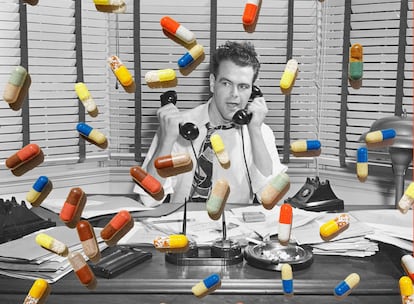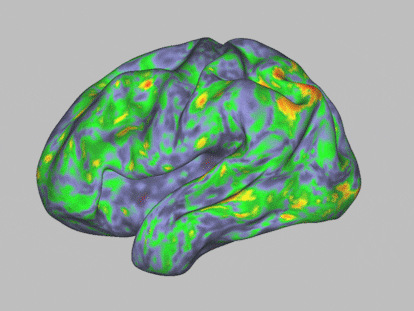‘At work, I was a machine, more productive’: Why do people take drugs in the office?
It’s not just Wall Street or Silicon Valley. The pressure to maintain productivity, the onset of burnout syndrome, and the drive to enhance creativity are all reasons why substance use continues to persist in the workplace


“If you use too much ketamine, you can’t really get work done. I have a lot of work, I’m typically putting in 16-hour days, so I don’t really have a situation where I can be not mentally acute for an extended period of time,” Elon Musk said in an interview with Don Lemon earlier this year.
In the interview, Musk — who will soon serve as a key advisor to incoming U.S. President Donald Trump — revealed that he takes doctor-prescribed ketamine every few weeks for an ailment that remains somewhat unclear, mentioning conditions like depression, intrusive thoughts, and mental block.
Pressed by Lemon on whether drug use might impact his work or concern Wall Street investors, Musk responded: “From a standpoint of Wall Street, what matters is execution. Are you building value for investors? Tesla is worth about as much as the rest of the car industry combined, so from an investor standpoint, if there is something I’m taking, I should keep taking it.”
But the revelations about the business tycoon’s ketamine use did spark some concern. Known as a dissociative anesthetic, ketamine is prescribed for treatment-resistant depression, particularly when traditional antidepressants fail, which seems to be the case for Musk. But it is also used as a recreational drug: Matthew Perry died of an overdose last year.
Depictions of workplace drug use, seen in The Wolf of Wall Street and the series Industry, suggest a corporate culture where substances are as common as morning coffee. But this fictional scenario has basis in reality. “Routine drug use has moved from an after-hours activity squarely into corporate culture, leaving boards and business leaders to wrestle with their responsibilities for a workforce that frequently uses,” write Kirsten Grind and Katherine Bindley in The Wall Street Journal. “At the vanguard are tech executives and employees who see psychedelics and similar substances, among them psilocybin, ketamine and LSD, as gateways to business breakthroughs.”
Microdosing — ingesting sub-perceptual amounts of psychedelics — has made its way into mainstream discussion, featured in shows like The Good Fight. In professional settings, microdosing is believed to boost performance, productivity, and creativity. Yet, as noted by Drogopedia, an online resource spearheaded by psychopharmacologist Antón Gómez-Escolar, current clinical trials offer limited support. “So far, this practice has not demonstrated greater efficacy than a placebo,” the site states. “For now, positive neuronal effects have only been demonstrated in mice, and we do not know its risk profile in humans either.”
The psychedelic industry is projected to reach $11 billion by 2027, and for many workers, these substances have become a part of their daily lives. In Spain, Carlos, a 42-year-old executive in the cultural sector, says microdosing enhanced his creativity. “I took two cycles of a couple of months each. One dose every three days. I wanted to be more awake in life, like… opening the third eye,” he says. “You walk down the street and notice things you didn’t see before: a beautiful balcony, for example. I felt calmer, more relaxed, and at work I was a machine: in a good mood, more productive. You’re not high, but you’re a better worker and almost better at everything else.”
Meanwhile, Ramiro, a 45-year-old engineer, tried microdosing as a remedy for work-induced stress and burnout syndrome. “I had easy access to these types of substances and had read several articles about their use as an antidepressant,” he explains. “I started with psilocybin, which is the substance found in hallucinogenic mushrooms. The effects are similar to those of LSD, but they last five or six hours. I started when I went to the office on a public holiday, because I thought there would be no one there. I put a microdose in my yogurt for breakfast and, when I got on the train, I felt like crying when I saw the front page of the newspaper that a man was reading. Then I realized that it was having an effect on me.”
When he arrived at work, he realized he was not the only one who had decided to come in that day. When a colleague suggested they have coffee, Ramiro was on edge. “I was afraid to talk after the train episode, so during that endless coffee, I just nodded,” he recalls.
Ramiro says it was hard to gauge the right dose. “The pattern is: one day on, two days off. I realized that I had to lower the dose, and I did so for a while, until I stopped feeling slightly high. My dose was much smaller than the articles say, where they explain that it is a tenth of a full dose, which for me is a lot.”
Even still, the experience was not what he was after. “I stopped because it didn’t work for me,” he continues. “I tried LSD, because it lasts twice as long — the effect of psilocybin, if you take it at breakfast, is over by lunch — while LSD lasts practically all day. However, with LSD it was more complicated to calculate the doses. In the end the problem was not fixed by drugs. Changing jobs is what did it.”
Experts like Fernando Ribas de Pina Pérez and Dioni Contreras Casado from the Proyecto Hombre Association emphasize that the uptick in workplace drug use underscores a need for better mental health support. “It is crucial that companies recognize these problems and take steps to support the mental health and well-being of their employees,” the experts argue. “This may include implementing programs promoting a healthy work-life balance, and creating a work environment that reduces stress and encourages mutual support.”
A report by Morgan Stanley notes that the psychedelic industry is gaining attention, pointing to “promising academic studies” and ongoing clinical trials with potential FDA approval for various compounds. The use of psychedelics in the workplace, aimed at enhancing performance and managing stress, is not a new phenomenon but is still relevant today. This reality is captured in shows like Exit, a series inspired by the real accounts of four successful investors who turn to drugs to combat professional and personal exhaustion. A Business Insider report — featuring interviews with 13 current and former finance professionals, as well as health experts — also confirmed that substance use in high-pressure industries remains pervasive.
Anna Lembke, physician and director at Stanford University’s Addiction Medicine Dual Pathology Clinic, notes that drugs, like cocaine and Adderall, commonly used to treat ADHD, are prevalent in the financial industry as “vehicles to work more, to work harder, stay awake, and boost success.” John Battaglia, a former salesman for major financial firms, says it’s not uncommon to find a number of drugs on Wall Street, referring to Adderall as “prescription cocaine.”
In some situations, people coming out of rehab take drugs to deal with the work environment. “In fact, these are not unusual cases,” say Ribas de Pina Pérez and Contreras Casado. “People who, in order to keep up with the pace of work, to perform better, to be able to integrate into the work environment or to compensate for lack of sleep, choose to consume different addictive substances.”
“Rehabilitation is a complex process that requires a comprehensive approach,” they continue. “Treating addiction involves addressing the underlying causes that led to the addictive behavior. This may include stress management, improving working conditions, developing skills to cope with work pressures in a healthy way, improving communication and emotional management skills, among others.”
As in any other field, drug use must be understood as a consequence and not as a cause. Perhaps combating stress, frenetic schedules and excessive pressure is the first step in rehabilitation.
Sign up for our weekly newsletter to get more English-language news coverage from EL PAÍS USA Edition
Tu suscripción se está usando en otro dispositivo
¿Quieres añadir otro usuario a tu suscripción?
Si continúas leyendo en este dispositivo, no se podrá leer en el otro.
FlechaTu suscripción se está usando en otro dispositivo y solo puedes acceder a EL PAÍS desde un dispositivo a la vez.
Si quieres compartir tu cuenta, cambia tu suscripción a la modalidad Premium, así podrás añadir otro usuario. Cada uno accederá con su propia cuenta de email, lo que os permitirá personalizar vuestra experiencia en EL PAÍS.
¿Tienes una suscripción de empresa? Accede aquí para contratar más cuentas.
En el caso de no saber quién está usando tu cuenta, te recomendamos cambiar tu contraseña aquí.
Si decides continuar compartiendo tu cuenta, este mensaje se mostrará en tu dispositivo y en el de la otra persona que está usando tu cuenta de forma indefinida, afectando a tu experiencia de lectura. Puedes consultar aquí los términos y condiciones de la suscripción digital.
More information
Archived In
Últimas noticias
Most viewed
- Reinhard Genzel, Nobel laureate in physics: ‘One-minute videos will never give you the truth’
- Oona Chaplin: ‘I told James Cameron that I was living in a treehouse and starting a permaculture project with a friend’
- Pablo Escobar’s hippos: A serious environmental problem, 40 years on
- Charles Dubouloz, mountaineering star, retires at 36 with a farewell tour inspired by Walter Bonatti
- Why we lost the habit of sleeping in two segments and how that changed our sense of time










































